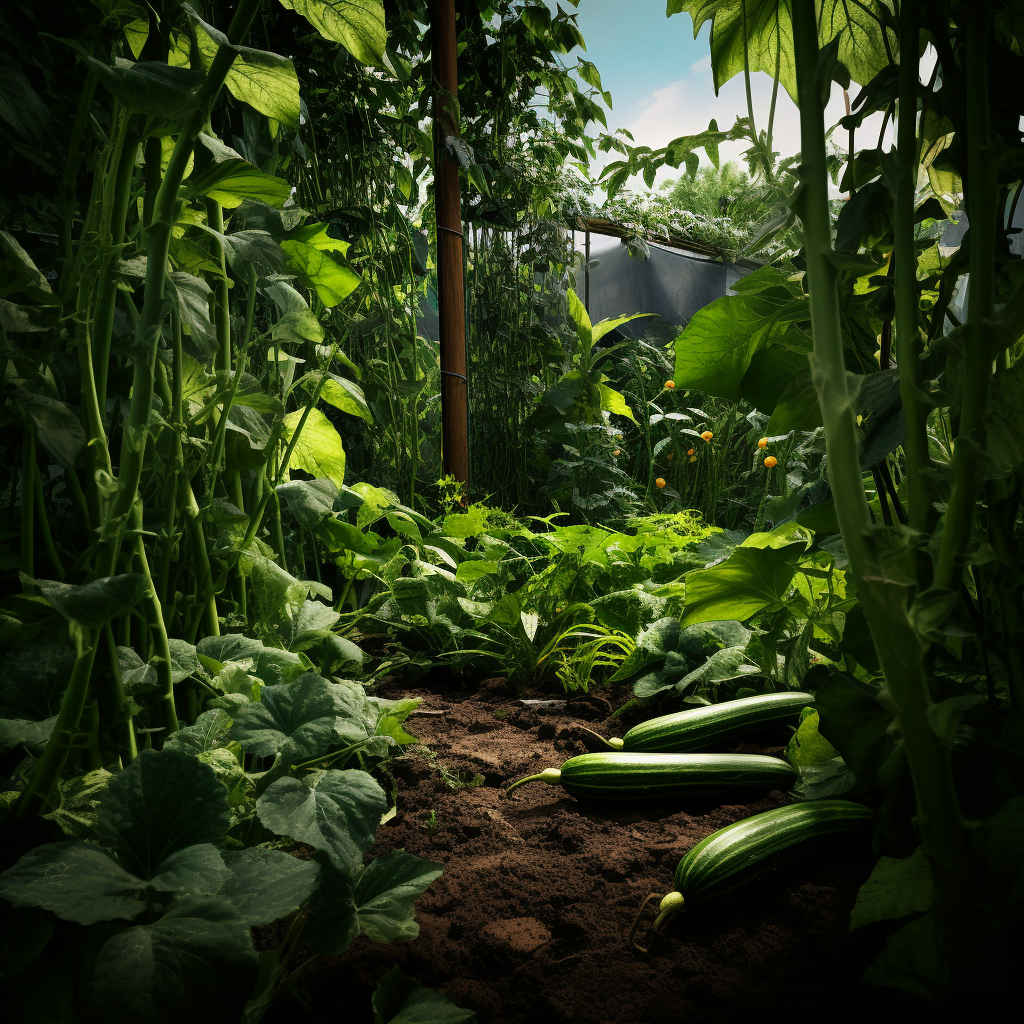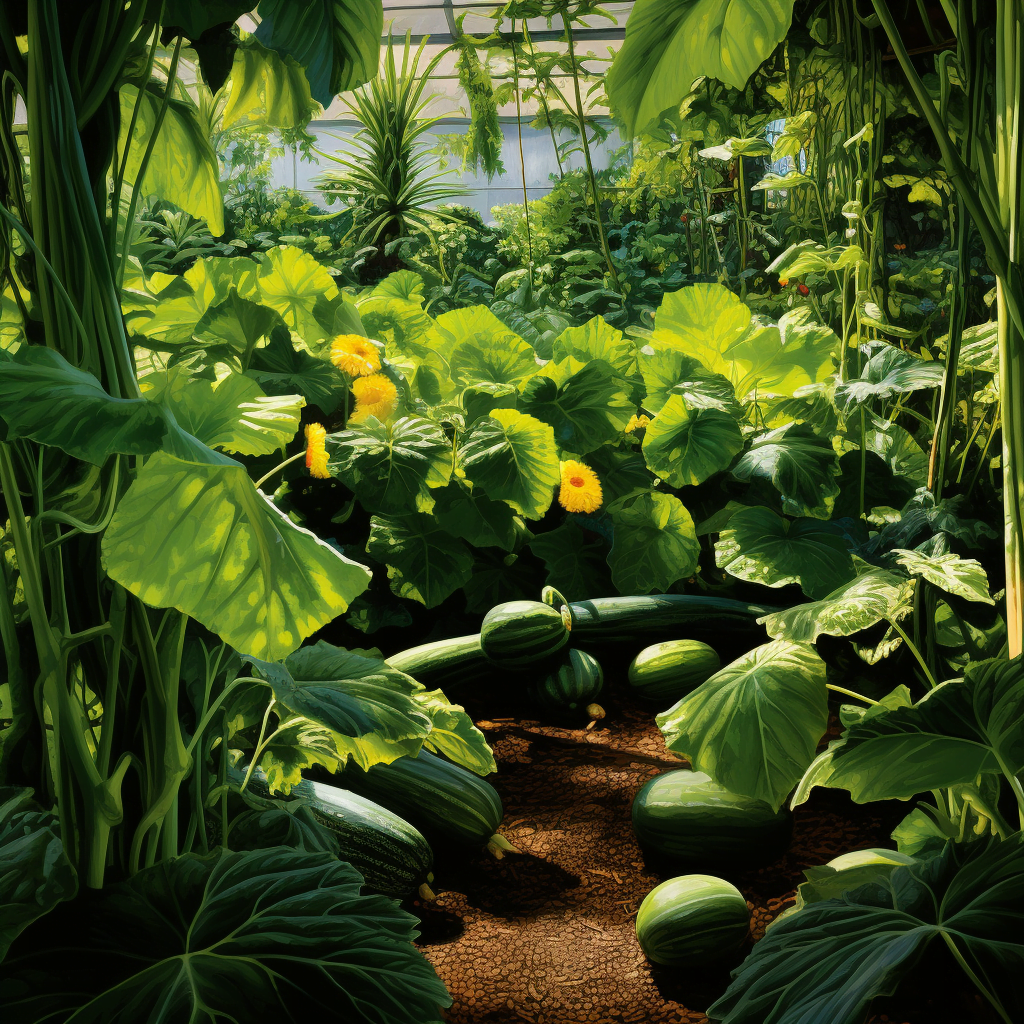Zucchini is a warm-weather crop that can be grown successfully throughout most of Texas. Deciding when to plant zucchini depends on your region’s climate and average last spring frost date. With proper timing and care, Texas gardeners can enjoy prolific harvests of zucchini all season long. So.. How and When to Grow Zucchini in Texas… keep reading and you will find out.
An Introduction to Growing Zucchini in Texas
Zucchini is a popular summer squash that originated from Central America and was brought to Europe in the late 15th century. It’s botanical name is Cucurbita pepo. Zucchini is loved for its versatility in the kitchen—the soft, mild fruits can be sautéed, baked, grilled, or added to all kinds of recipes from appetizers to desserts!
In Texas, zucchini thrives during the hot, sunny summers. The long growing season allows for harvests from early summer through the first fall frosts. With the right care, zucchini is generally an easy crop for novice and experienced gardeners alike to grow successfully. The fast-growing vines continuously produce new zucchini fruits if harvested frequently. Just a few plants can yield enough tasty zucchini to enjoy fresh and preserve the extras.
When planted at the proper time, zucchini will flourish in gardens across Texas. However, the ideal planting dates vary by growing zone. Read on for a complete guide to timing, planting, caring for, and harvesting zucchini in the Lone Star State.
Zucchini Growing Conditions in Texas
Zucchini thrives in the hot, sunny summers in Texas. Here are the ideal growing conditions:
- Temperature: Zucchini grows best in warm conditions, ideally between 60-85°F. It does not tolerate frost or freezing temperatures.
- Sun: Zucchini needs at least 6-8 hours of full sun exposure each day. Partial shade will result in reduced yields.
- Soil: Plant zucchini in rich, well-draining soil. The ideal pH range is between 6.0-7.0. Amend clay or sandy soils with compost.
- Water: Zucchini is fairly drought-tolerant but regular watering is needed for the best harvests. Provide about 1 inch of water per week.
- Growing Season: Thanks to the long, hot growing season, zucchini can be planted early spring through mid-summer in most parts of Texas.
Ensuring zucchini plants have optimal sun, soil, and water will provide the right conditions for an abundant harvest. Pay special attention to sun exposure as zucchini plants may spread well beyond their initial planting spot. Keep the vines in the sun by pruning back foliage or moving plants.
Choosing the Best Variety of Zucchini
There are many great zucchini varieties to choose from:
- Black Beauty: A classic heirloom with glossy dark green skin and creamy white flesh. It has an open, spreading bush habit.
- Golden Zucchini: As the name suggests, this variety has vibrant golden-yellow skin. It has a mild, nutty flavor.
- Eight Ball: A compact bush zucchini that produces round, baseball-sized fruits. Great for containers.
- Raven: This AAS winner variety resists powdery mildew disease and yields glossy, deep green fruits.
- Costata Romanesco: An Italian heirloom known for its embellished, ribbed skin pattern.
- Ambassador: A disease-resistant hybrid that produces high yields on an open, easy to manage plant.
Match the zucchini variety to your growing needs. Compact bush types work well in containers while vigorious vines are suited to gardens.
When to Plant Zucchini
Zucchini can be planted in both spring and summer in Texas:
- Spring: Early spring planting between March-April will give your zucchini plants enough time to mature and produce multiple harvests before the peak heat of summer.
- Summer: Plant zucchini again in early summer (June-July) for a fall zucchini crop.
Avoid planting zucchini too early in the year when cold spells may stunt growth. Wait until daytime and nighttime temperatures remain reliably warm before sowing or transplanting zucchini.
Staggering zucchini plantings throughout spring and summer extends your harvest season. With proper care, zucchini will continue producing fruits all season long from just 1-2 plantings.
Deciding on the Best Planting Dates
The ideal planting dates for zucchini vary across different regions in Texas:
- North Texas: Plant zucchini in April or May after the last expected frost date has passed.
- Central Texas: Zucchini can be planted from March through June. Stagger plantings for continuous harvests.
- South Texas: Gardeners in south Texas can start zucchini as early as February thanks to the warm climate.
- Watch the Weather: Monitor weather reports in your local area and only plant zucchini after the risk of frost has passed. Zucchini seeds will not germinate in cold soil.
The average last spring frost dates across Texas are:
- Dallas-Ft. Worth: March 15
- Austin: March 15
- San Antonio: February 20
- Houston: February 15
- South Texas: January 30
Refer to zone maps to determine your expected last frost date. When in doubt, wait a week or two past the average date before sowing zucchini.

How to Start Zucchini from Seed
Zucchini can be started from seed directly in the garden, but beginning seeds indoors gives plants a head start:
- Start seeds indoors 3-4 weeks before your target transplant date.
- Use biodegradable pots, peat pots, or other small containers.
- Fill containers with a lightweight seed starting mix.
- Sow 1-2 seeds in each pot, 1 inch deep.
- Keep seedlings warm (60-75°F) and moist until sprouting.
- Thin to one plant per pot after sprouting. Discard (or re-plant) the weaker seedling.
- Harden off transplants for 7-10 days before transplanting by slowly exposing them to outdoor conditions.
How to Transplant Zucchini
Here are some tips for transplanting zucchini seedlings:
- Transplant after daytime and nighttime temps stay above 50°F.
- Carefully dig holes 12-18 inches apart in rows or hills.
- Gently remove seedlings from pots, disturbing roots as little as possible.
- Place plants in holes at same level as in container, then fill in with soil.
- Water transplants immediately and provide shade if transplanting in very hot weather.
Direct Sowing Zucchini
It’s also possible to directly sow zucchini seeds into the garden:
- Wait 2-3 weeks past your zone’s average last spring frost date.
- Till garden soil and rake smooth to create planting beds.
- Sow seeds 1 inch deep and 6-12 inches apart in rows or hills.
- Thin seedlings to 12-24 inches apart.
- Cover with cloches, fabric row covers, or tunnels to protect from cool weather.
Whether growing transplants or direct sowing, add a balanced granular fertilizer to the soil 2-3 weeks after plants emerge.
Caring for Your Zucchini Plants
Here are some tips for caring for your zucchini plants throughout the growing season:
- Watering: Supply around 1 inch of water per week. Water at the base.
- Weeding: Weed around plants and mulch to prevent weeds.
- Fertilizing: Fertilize plants every 3-4 weeks with a balanced 10-10-10 fertilizer following label rates.
- Support: Use trellises and cages to support vigorous vines off the ground.
- Pest control: Watch for squash bugs, cucumber beetles, and other pests. Pick off any spotted leaves or vines. Use organic pesticides only when absolutely needed.
- Pollination: Encourage pollination from bees by avoiding use of insecticides. Hand pollinate flowers if needed.
With attentive care throughout the season, your zucchini plants will be healthy and productive.
When and How to Harvest Zucchini
- Begin harvesting zucchini fruits when they are 6-8 inches long for best flavor and texture.
- Use a sharp knife or pruners to cut zucchini from the vine, leaving about 1 inch of stem attached.
- Check plants daily and harvest zucchini every 2-3 days during peak season for highest yields.
- Pick even small immature fruits to encourage the plant to continue producing.
- During hot mid-summer weather, zucchini plants will slow down producing. Keep plants constantly picked to extend harvests into the fall before first frost.
Storing Your Zucchini Harvest
Enjoy fresh zucchini right after picking or store the bountiful harvest:
- Store unwashed zucchini in plastic bags in the refrigerator crisper drawer for 7-10 days.
- Leave on stem end intact until ready to use. Wash just before eating.
- Freeze grated or sliced zucchini in airtight containers or freezer bags for 6-12 months. Great for adding to baked goods.
- Pickle sliced zucchini or shred and make a zucchini relish. Properly canned pickles and relish will keep for over a year.
- Can or jar diced, sliced, or grated zucchini in a water bath canner. Use within 1 year for best quality and safety.
- Dehydrate shredded zucchini in a food dehydrator into zucchini “chips” for healthy snacking. Store in an airtight container.
With so many preservation methods, you can enjoy zucchini all year round!
Getting the Most Out of Your Zucchini Plants
Here are some tips for maximizing your zucchini harvest:
- Choose disease-resistant varieties like Black Beauty or Ambassador. This avoids problems like powdery mildew.
- Practice crop rotation each season to prevent disease and nutrient deficiencies in the soil.
- Use floating fabric row covers over plants to provide protection from insect pests. Remove during flowering for pollination.
- Apply organic neem oil on plants as needed to deter pests like squash bugs.
- Stay vigilant in monitoring plants and promptly remove diseased or pest-damaged fruits.
- Use organic kelp fertilizer and compost tea to nourish plants and stimulate growth.
- Prune excessive foliage to allow sunlight and air circulation within plant canopy.
- Hand pollinate flowers by transferring pollen between male and female blooms using a cotton swab.
Troubleshooting Common Zucchini Plant Problems
Why do my zucchini plants have yellow leaves?
Yellowing leaves can indicate issues like nutrient deficiencies, dampening off disease, viruses, or powdery mildew fungus. Ensure plants get proper fertilization and avoid overwatering. Improve air circulation and spray neem oil if powdery mildew is present.
Why aren’t my zucchini plants flowering?
Hot weather over 90°F, excessive nitrogen fertilizer, overwatering, or lack of pollinators can prevent flowers. Try shading plants during hot spells, use more balanced fertilizer, improve drainage, and hand pollinate flowers.
How do I avoid bitter-tasting zucchini?
Allowing fruits to overmature on the vine can cause bitterness as seeds and rind become tough. Harvest zucchini when 6-8 inches long for best flavor. The skin should be glossy with a bright color.
Why do zucchini flowers fall off without producing fruit?
Poor pollination is the most common cause of flowers falling off before setting fruit. Make sure plants are getting adequate sunlight and heat. Hand pollinate using a cotton swab if needed.
How can I deal with squash vine borers?
Prevent these pests by spraying beneficial nematodes early in season. Cover stems with aluminum foil or floating row covers to block the moths. Remove borers with a knife if infestation is minor.
Enjoying Your Zucchini Harvest
The harvests from just 2-3 zucchini plants can supply more than enough fruits for any family. Here are some ways to enjoy zucchini:
- Slice and pan fry zucchini with olive oil, garlic, and herbs for a quick and healthy side dish.
- Shred or spiralize zucchini into “zoodles” as an alternative to pasta.
- Bake grated or chopped zucchini into breads, muffins, and cakes for added moisture.
- Stuff halved or quartered zucchini with savory fillings like rice, meat, cheeses as fun appetizers.
- Grill thick zucchini slices or spears brushed with olive oil for flavorful char marks.
- Grate and add raw zucchini into dips, salads, and salsa for extra nutrition.
With so many ways to cook zucchini, you’ll enjoy finding new recipes to use up all that homegrown summer goodness!
Conclusion
With the right planting schedule and care, Texans can grow prolific crops of zucchini. Pay attention to average last spring frost dates for your area. Provide consistent watering, fertilization, and pest prevention. Harvest fruits young and often. Choose disease-resistant varieties suitable for your climate. Follow these tips and enjoy fresh zucchini straight from your garden all season long!



